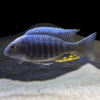-
×
-
×
-
×
-
×
-
×
-
×
Subtotal: £131.45



















Mike Thompson (verified owner) –
I recently added a Calico Peacock Cichlid – Aulonocara Sp. Calico – Malawi Cichlid to my aquarium, and I couldn’t be happier! From the moment I introduced him, he brought a burst of vibrant color to my tank. Within just a week, I noticed his playful nature; he darts around, showcasing those stunning blue and orange hues.
I’ve kept cichlids for years, but this variety stands out for its personality. Unlike some other cichlids I’ve tried, the Calico Peacock is not overly aggressive, which makes it a fantastic addition for a community tank. I see him interacting with my other fish gracefully, which is a testament to its friendly demeanor.
One minor consideration is that they thrive best in slightly warmer water, so I had to adjust my heater a bit, but it was worth it! If you’re looking for a colorful, engaging fish that brings joy, I highly recommend the Calico Peacock Cichlid. Perfect for both experienced hobbyists and those new to the cichlid world. Plus, it’s a great conversation starter! Don’t hesitate to add one to your tank—you won’t regret it!